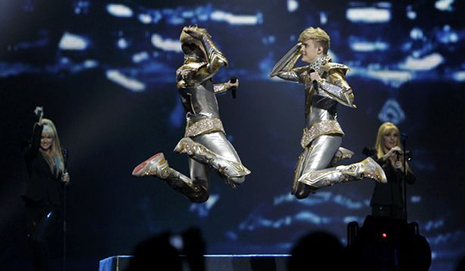Sweeping into town on the wide new motorway, I was taken aback by the scale of the urban development rising out of the night. We sped past a pastiche of refurbished Soviet-era blocks, garish modern neoclassical towers, and ultra-contemporary high-rises of curved glass and steel lit in a multitude of colours.

There were petrol stations that looked like sci-fi spaceports. Glitzy upmarket boutiques. A giant illuminated seafront promenade arcing far into the distance. And above it all stood three surreal flame-shaped towers, their flashing fire-like lights licking the night sky.
This wasn’t what I’d expected. This wasn’t how I’d imagined this part of the world. This was Baku, the capital of Azerbaijan – a country you probably know little about.
“You’re going where?” was the usual response I got before leaving. That, or blank looks, or concerned expressions.
So I had to explain: It’s a small former Soviet republic at the junction of Europe, the Middle East and Central Asia, on the shores of the Caspian Sea, sandwiched between the giants of Russia and Iran.
No, it’s not in the Middle East. And, no, it’s not getting sucked into the crisis there. But it is ridiculously rich in oil and gas. And it no longer wants to be the place people know nothing about. It craves global recognition – and has big plans to get it.
It has already hosted the Eurovision Song Contest – in 2012. Its Land of Fire logo is currently being broadcast around the globe on the shirts of Atletico Madrid, the current Spanish league champions. In 2016 it will become a Formula One city.
And next June it will host the inaugural European Games – a regional variation of the Olympics (even though it’s not really in Europe).
What should properly put the country in the spotlight, though, is the construction of the world’s tallest building – the Azerbaijan Tower – a monstrously large edifice that at 3,445ft high will dwarf the current record holder, the 2,722ft Burj Khalifa in Dubai.
Not that I knew much of this beforehand. I’d heard Azerbaijan has been booming since independence from Russia. But I didn’t realise it was hoping to be the new Dubai, similarly splurging its petrodollars before the wells run dry.
In days of old, the natural gas was so abundant it would spontaneously combust on the surface, giving rise to the name of Azerbaijan – Land of Fire.

The flame is now the national symbol, so the three Flame Towers have taken on iconic proportions. In the top half of one of them is the luxurious Fairmont hotel, which was to be my home for my stay. Lucky me. The view from up there was incredible. A vista sweeping across the city and far out to the Caspian.
The Baku I looked down upon is almost unrecognisable from the one at the start of the current boom 19 years ago, yet hopes to continue apace for the next few decades with eye-popping architecture that will make the current crop pale in comparison.
One part of town which won’t be changing is the Unesco-listed Old City. I wandered its pretty cobblestone streets the following morning, taking in the ancient architecture that reflects its complex history.
Ethnically, the Azeris are a Turkic people whose lands have been part of the Arab, Persian, Ottoman and Russian empires, finally gaining independence in 1991 after the collapse of the Soviet Union.
The vast majority of Azeris are Muslims, though you can’t really tell from people’s appearance.
I hardly spotted anyone wearing traditional clothes, or a headscarf, or men sporting beards. Their rest day is Sunday, and there are relatively few mosques. I knew due to the Soviet legacy it was officially secular, but not that secular.
This also means that alcohol is widely available. Yay! There’s plenty of vodka and decent local wine to be had with their great Middle Eastern-style cuisine of meze, grilled meats, flatbreads and salads. I ate just such a lunch that day in the Mugam Club, a traditional caravanserai whose elaborate fountained courtyard was once a pit stop for camels and traders on the ancient Silk Road.
In the areas surrounding the Old City walls, you find ornate mansions from the original oil boom of the 19th century, as well as some grand 20th century architecture. But the cream of Baku’s buildings – the Heydar Aliyev Cultural Center – is amid the urban sprawl where the population has grown from 5,000 to three million in around 150 years.
Designed by British-Iraqi architect Zaha Hadid, this liquid-like freeform structure is not only the most beautiful in town, but also the best example of modern architecture I’ve ever seen (and far more interesting than the exhibitions it housed).

Of course, with such rapid expansion and vast amounts of money swilling around, there are concerns for corruption, ecological issues and human rights abuses. And despite all the changes, the place retains a Soviet feel – especially in the desolate outskirts, in the sullen faces of locals who haven’t yet learned that smiling’s OK, and especially in the ever-present security measures.
Men in black – in the guise of police, or military, or private security – are everywhere in Baku. A tad disconcerting, but I soon learned to feign obliviousness to their beady-eyed stares.
On my third day, I went on a trip to the nearby Unesco World Heritage Site of Gobustan, with its thousands of years’ worth of impressive prehistoric petroglyphs carved into rock faces.
The surrounding area was bleak, yet fascinating. Ridges of low, dark mountains propped up heavy skies as we drove through an industrial landscape of shipyards, factories, oil plants and rigs, the rocky desert soil rendered barren by a concoction of oil, methane and the saline water of the Caspian that now shone a surprisingly iridescent turquoise.
We passed the site of the Khazar Islands, the Dubai-inspired mega-development that’s part of the master plan to put Azerbaijan on the map.
Amid the relentless grey stood rows of forlorn palm trees. It was hard to envisage that one day it will apparently be a magnificent archipelago of approximately 50 artificial islands, home to 800,000 people and the behemoth Azerbaijan Tower.
There’ll also be room for 200,000 tourists. By which stage, of course, Azerbaijan is hoping its plans will have paid off. That Baku will be a city you – and the world – will know quite a bit about.
Is it safe?
In a word, yes. There is little crime and, unlike Chechnya and Dagestan, Azerbaijan broke away freely from Russia. But after centuries of empire, the demarcation of borders with Armenia was complicated. The result was a brutal war from 1988-94 over the region of Nagorno-Karabakh, which has been occupied by Armenia since the ceasefire. There’s been a bitter 20-year stand-off, and some skirmishes over the summer, but President Putin stepped in to mediate.
Get there
British Airways Holidays has 3nts r/o at the 5* Fairmont Baku, Flame Towers from £869pp for selected departures Mar-Jul. Inc flights from Heathrow. Book by Nov 30. ba.com/baku 0844 493 0758.
A 15-day single entry tourism visa costs around £63 (pay in advance) and takes about 15 days to receive. The Fairmont Baku can assist with the process. fairmont.com/baku
Tourist info: azerbaijan.travel
Time zone: UK +4hrs
Currency: Manat £1 = 1.26
Best time to go Warm to the Land of Fire next spring
















































